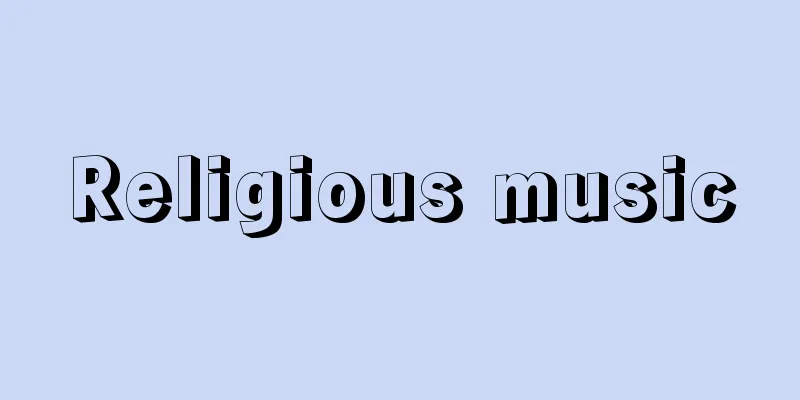Religious music

|
Music that is performed in some way linked to religion. The connection between music and religion is extremely deep, and religions throughout history and around the world have each developed their own unique religious music, which comes in a wide variety of styles and types. This may be because music uses sound that is not bound by form as its material and can bring about direct emotions that go beyond logic, which in some sense creates a kind of similarity with religion. As seen in the story of Orpheus, the musician in Greek mythology, there are many legends in which the creator of music or musical instruments is made a god and the mystical power of music is praised all over the world, and in primitive religions, musical acts can be considered to be religious acts. In the magic and sorcery of primitive societies that did not have anything that could be called religion, people would use a special voice that was not their everyday voice when casting spells or praying, in other words, they would transcend themselves and transcend humanity through a kind of singing act, and such examples can be found all over the world. In this way, we can say that religion is also linked to the origin of music. Music has also played an extremely important role in the religions of cultural nations. Brahmanism, Hinduism, Buddhism, Tibetan Buddhism (Lamaism), and other religions have formed their own unique religious music in each region. The idea of "unity of ritual and music" is seen in Chinese Confucianism. Japan's Shinto and Buddhism have also developed their own unique musical styles, such as Kagura (Mikagura), Azuma Asobi, and Matsuribayashi in the former, and Shomyo, Mousou Biwa, and Fuke Shakuhachi in the latter. It is clear from records and traditions that music was also performed in connection with religious events in ancient Mesopotamia, Egypt, Greece, Rome, and other places. It can also be seen that dance, linked to music, played a fairly important role in the above religions. Of the major religions of the past and present, Islam is the only one that has a negative attitude toward music and, in principle, rejects the use of music in worship. It is noteworthy that, although its orthodox doctrine does not accept music as something that brings about sensual pleasure, there is a clear musical development in the recitation of the Quran and in the adhan, a call to prayer, regardless of the awareness of the people involved. In contrast, Judaism and Christianity, which was established under its strong influence, place great importance on music, reflecting their doctrine, and have actively cultivated artistic religious music. However, even within Judaism, the beautification and technicalization of church music has been a problem since the Middle Ages, and bans have been issued on numerous occasions. The most famous example is the 16th century Council of Trent (the first general council of the Catholic Church held in the Cathedral of Trent in 1545), which tried to ban technical religious music, but music ultimately survived, and Christian music today accounts for a very large proportion of music in the world. For this reason, even in Japan, the term religious music was usually understood to mean Christian music, but in recent years, with the progress of research in the field of folk music, there has been a reexamination of the music of various regions and religions and their interrelationships. Using the most highly developed Christian music as an example, religious music can be broadly divided into six categories: (1) liturgical music for worship ceremonies, (2) semi-liturgical music that can be used for worship as a matter of convenience, (3) music for religious events that are not formal liturgies but are customarily performed in churches, (4) private prayer and evangelistic music to encourage and propagate the faith of believers, (5) religious folk songs, and (6) religious concert music for appreciation based on religious themes. The names and scope of these categories vary depending on the denomination and sect. [Tatsuo Minagawa] [References] | | |Source: Shogakukan Encyclopedia Nipponica About Encyclopedia Nipponica Information | Legend |
|
宗教となんらかの形で結び付いて演奏される音楽。音楽と宗教の結び付きはきわめて深く、古今東西の宗教はそれぞれ独自の宗教音楽を発展させており、その様式や種類も非常に多い。これは、音楽が形にとらわれない音を素材にし、論理を超えて直接的な感動をもたらしうることが、なんらかの意味で宗教と一種の類似性をつくりだしているためとも考えられる。 ギリシア神話の楽人オルフェウスの物語にもみられるように、音楽あるいは楽器の創始者を神とし、また音楽の力の神秘さをたたえる説話は世界各国に広く認められるものであり、原始宗教においては音楽的行為即宗教的行為とみなしうるものが少なくない。また、宗教とよべるほどのものをもたない原始社会の呪術(じゅじゅつ)や魔術においては、呪文や祈祷(きとう)の際、日常の声ではない特別な声を使い、つまり一種の歌う行為によって自分を超え、人間を超えるのであり、こうした例は世界各地にみいだすことができる。このようにみると、宗教は音楽の起源とも結び付いているといえよう。 文化民族における宗教においても、音楽はきわめて重要な地位を占めてきた。バラモン教、ヒンドゥー教、仏教、チベット仏教(ラマ教)などは、それぞれの地域に固有の宗教音楽を形成してきた。中国の儒教には「礼楽一致」の思想がみられる。日本の神道(しんとう)や仏教でも、前者には神楽(かぐら)(御(み)神楽)、東遊(あずまあそび)、祭囃子(まつりばやし)など、後者には声明(しょうみょう)、盲僧琵琶(もうそうびわ)、普化(ふけ)尺八など、独自の音楽を発展させている。古代メソポタミア、エジプト、ギリシア、ローマなどにも、宗教的行事に結び付いてそれぞれ音楽が行われていたことは、記録、伝承などから明らかである。そして以上の宗教では、舞踊も、音楽と結び付いてかなり重要な役割を果たしていたことがうかがわれる。 古今の大宗教のうち、音楽に対して消極的であり、原則として礼拝における音楽の使用を排するのはイスラム教だけといえる。その正統派は、教義上、音楽を官能的快楽をもたらすものとして容認していないにもかかわらず、コーランの読誦(どくしょう)や、礼拝の時を告げる呼びかけとしてのアザーンなどには、当事者の意識とはかかわりなく、明らかな音楽的展開が示されていることは注目されてよい。 これと対比的に、ユダヤ教、そしてその強い影響下で成立したキリスト教は、その教義を反映して音楽を重要視し、積極的に芸術的な宗教音楽を育成してきたのであるが、この内部でも、中世以来、教会音楽の美化、技巧化が問題とされ、禁令の出されることもたびたびであった。そのもっとも有名なものが16世紀のトレント公会議(1545年に初めてトレントの聖堂で開かれたカトリック教会総会議)で、技巧的な宗教音楽を追放しようとしたが、結局音楽は生き延び、今日の世界の音楽のなかでキリスト教音楽の占める比重はきわめて大きなものがある。そのため、日本においてさえも、宗教音楽の語はキリスト教音楽の意味で理解されるのが普通であったが、近年では民族音楽の分野の研究の進歩とともに、各地・各宗教の音楽とその相互関係などについての再検討が進められている。 なお、もっとも高度に発達したキリスト教音楽を例にとって宗教音楽を区別すると、大きく次の六つに分けることができる。(1)礼拝儀式のための典礼音楽、(2)便宜的に礼拝に使用できる準典礼音楽、(3)正規の典礼ではないが習慣的に教会で執行される宗教行事のための音楽、(4)私的な祈り、信徒の信仰を励まし、布教するための伝道音楽、(5)宗教民謡、(6)宗教的題材によった鑑賞のための演奏会用宗教音楽、以上であるが、宗派・教派によりその名称と範囲には差がある。 [皆川達夫] [参照項目] | | |出典 小学館 日本大百科全書(ニッポニカ)日本大百科全書(ニッポニカ)について 情報 | 凡例 |
<<: Private church - Eigenkirche
>>: Employee stock ownership plan - Employees' holding system
Recommend
Muscle tissue
Muscle tissue is a tissue formed by the accumulati...
Jasmine - Jasumin (English spelling) jasmine
The English name of a plant in the genus Jasmine ...
Anthomyiidae
...A general term for insects in the Anthomyiidae...
Disturbance - Gairan
〘noun〙 An external factor that disrupts the operat...
The Westminster Terms
…Simon became the leader of the reform movement. ...
Raksasa (English spelling)
…In addition to these, there are eight groups of ...
Child, FJ (English spelling) ChildFJ
…In the Elizabethan era, it was common to print a...
palace
…In some cases, it is considered to be of the sam...
San Antonio
A commercial and industrial city in southern Texas...
Electrodialysis - Denki Touseki
When dialysis is performed on a colloid or polyme...
Albrecht
…the personal union of Denmark, Norway, and Swede...
Symbolic Voting - Symbolic Voting
A method of voting in an election. You vote by put...
Max Linder
1883‐1925 A French comic actor from the silent fil...
Oshirasawa Mountain - Oshirasawasan
…It was designated a special natural monument in ...
Exam - Kaishi
〘 noun 〙 One stage of the imperial examinations fo...








![Miyako [city] - Miyako](/upload/images/67ccf633b5411.webp)
